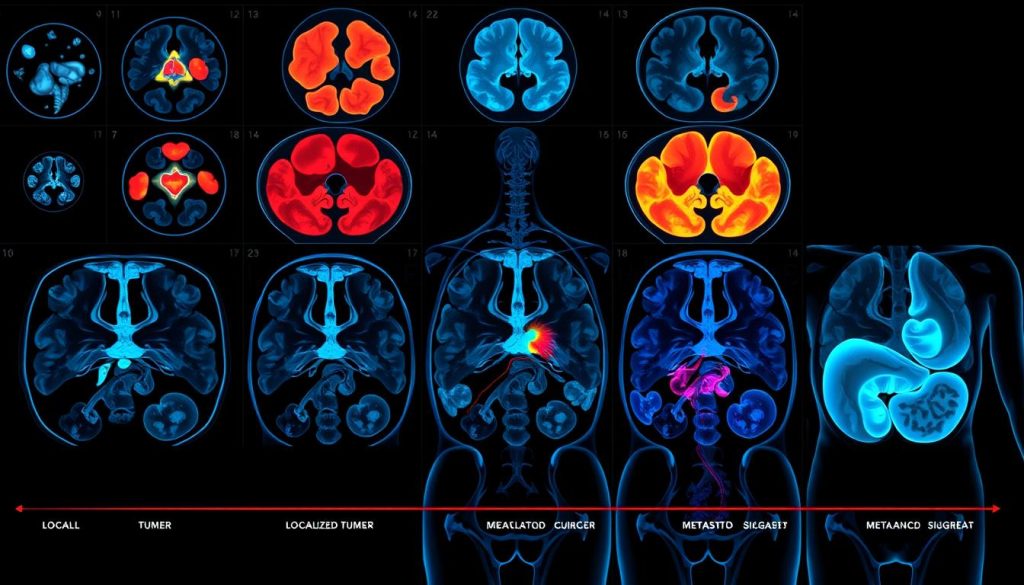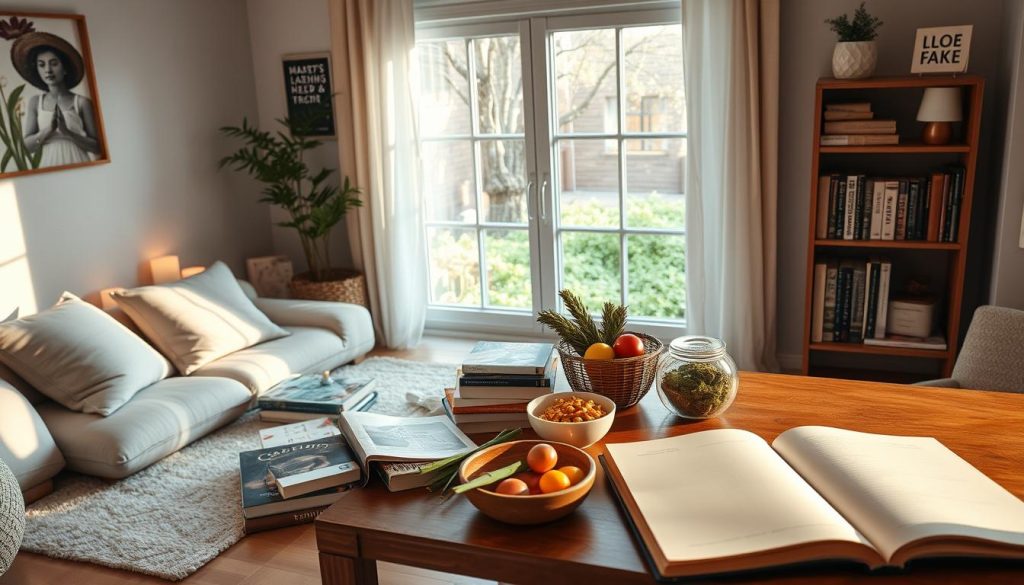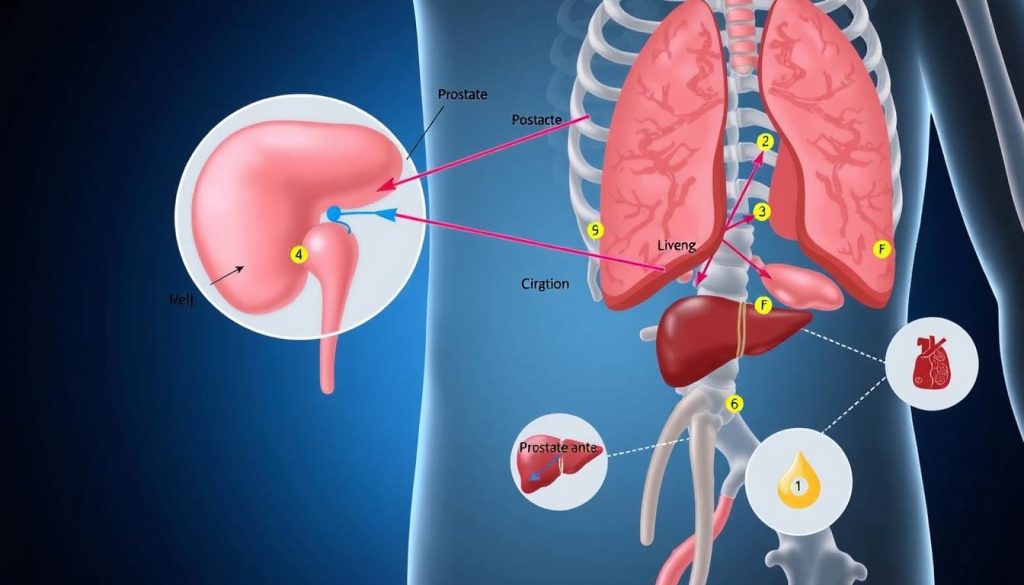When prostate cancer spreads, it’s a big change. This stage is tough for patients and their families. Knowing where it goes is key to managing it well.
Prostate cancer cells can leave the main tumor and travel. They settle in new places, creating more tumors. This changes how we treat it and affects the patient’s outcome.
We’ll look at how cancer cells move, where they go, and what it means for those dealing with it. Our goal is to help patients understand advanced prostate cancer better.
Understanding Prostate Cancer Metastasis: The Basics
Prostate cancer progression is a complex process that can lead to metastasis. This section explores the fundamentals of how prostate tumors spread and the factors that influence this progression.
What is Cancer Metastasis?
Metastasis occurs when cancer cells break away from the original tumor and travel to other parts of the body. In prostate cancer, this spread can significantly impact treatment options and patient outcomes.
How Prostate Cancer Cells Travel Through the Body
Prostate tumor spread typically follows these steps:
- Cells break off from the primary tumor
- They enter nearby blood or lymph vessels
- Circulate through the body
- Settle in new locations
- Form new tumors
Risk Factors for Metastatic Spread
Several factors can increase the likelihood of prostate cancer progression to advanced stages:
| Risk Factor | Impact on Metastasis |
|---|---|
| Gleason Score | Higher scores indicate more aggressive cancer |
| PSA Levels | Rapidly rising levels may signal spread |
| Tumor Stage | Advanced stages have higher metastasis risk |
| Genetic Mutations | Some mutations increase spread potential |
Understanding these basics of prostate cancer metastasis helps patients and doctors make informed decisions about treatment and monitoring. Regular check-ups and early detection remain crucial in managing prostate cancer stages and preventing spread.
Where Does Prostate Cancer Spread?
It’s important for patients and caregivers to understand where prostate cancer spreads. Secondary prostate cancer, or metastatic prostate cancer, can go to different parts of the body. Let’s look at the common places prostate cancer tends to spread to.
Bone Metastasis: The Most Common Site
Bones are the main target for prostate cancer to spread to. The spine, pelvis, and ribs are often affected. This can cause pain, fractures, and other bone problems.
Lymph Node Involvement
Prostate cancer usually goes to nearby lymph nodes first. This can happen before it reaches other organs. Swollen lymph nodes in the pelvic area might show cancer spread.
Spread to Other Organs
While less common, prostate cancer can also spread to other organs. The lungs and liver are possible sites for secondary prostate cancer. In rare cases, it might affect the brain or other soft tissues.
| Site | Frequency | Common Symptoms |
|---|---|---|
| Bones | Very High | Pain, fractures, weakness |
| Lymph Nodes | High | Swelling, discomfort |
| Lungs | Moderate | Shortness of breath, cough |
| Liver | Low | Abdominal pain, jaundice |
Knowing where prostate cancer spreads helps in early detection and targeted treatment. Regular check-ups and talking openly with healthcare providers are key to managing the disease well.
Signs and Symptoms of Metastatic Prostate Cancer
It’s vital to know the signs of advanced prostate cancer early. This is because the cancer can spread to other parts of the body. This can cause different symptoms.
Pain is often the first sign of metastatic prostate cancer. Bone pain in the spine, hips, or ribs can mean the cancer has spread. Some men also lose weight or feel very tired as their body fights the disease.
Urinary problems can get worse in advanced prostate cancer. You might have trouble urinating, need to go more often, or see blood in your urine. Swelling in your legs or pelvis can also happen due to lymph node involvement.
- Bone pain (spine, hips, ribs)
- Unexplained weight loss
- Fatigue
- Urinary difficulties
- Swelling in legs or pelvis
These symptoms can also be signs of other health issues. If you notice any, see your doctor right away. Catching metastatic prostate cancer early can greatly improve treatment options and results.
“Listening to your body and reporting any unusual changes to your healthcare provider is key in managing prostate health.”
Not all men with metastatic prostate cancer will show symptoms. Regular check-ups and screenings are crucial for those at risk or who have had prostate cancer before.
Advanced Prostate Cancer Staging and Diagnosis
Getting the right stage and diagnosis is key for knowing how to treat prostate cancer. Doctors use many tests to see how far the cancer has spread. This helps them choose the best treatment plan.
Imaging Tests for Detecting Metastasis
Imaging tests are very important for finding out where prostate cancer has spread. They help doctors see tumors and understand the cancer’s stage.
- CT scans: Detailed cross-sectional images of the body
- Bone scans: Detect cancer spread to bones
- MRI: High-resolution images of soft tissues
- PET scans: Show cancer activity throughout the body

Blood Tests and Biomarkers
Blood tests check for proteins that show if prostate cancer is getting worse. The most common test is the PSA (Prostate-Specific Antigen) test. High PSA levels might mean the cancer is growing or spreading.
Understanding TNM Staging
The TNM system helps classify prostate cancer stages. It looks at three main things:
| Factor | Description |
|---|---|
| T (Tumor) | Size and extent of the main tumor |
| N (Nodes) | Spread to nearby lymph nodes |
| M (Metastasis) | Spread to distant parts of the body |
By combining these factors, doctors figure out the overall stage. This stage ranges from I to IV. Knowing the stage is very important for understanding the cancer’s outlook and deciding on treatment.
Treatment Options for Metastatic Prostate Cancer
Treating metastatic prostate cancer needs a detailed plan. Doctors create treatments that fit each patient’s needs. They aim to slow cancer growth and enhance life quality.
Hormone therapy is key in treating advanced prostate cancer. It lowers testosterone, which helps cancer grow. Medications like Lupron or Zoladex are often used.
Chemotherapy is also important in fighting metastatic prostate cancer. Drugs like Docetaxel and cabazitaxel target fast-growing cancer cells. They’re used when hormone therapy stops working.
New targeted therapies offer hope for those with metastatic prostate cancer. Drugs like abiraterone and enzalutamide block cancer growth pathways. They help stop cancer from spreading.
| Treatment Type | Examples | How It Works |
|---|---|---|
| Hormone Therapy | Lupron, Zoladex | Lowers testosterone levels |
| Chemotherapy | Docetaxel, Cabazitaxel | Kills rapidly dividing cells |
| Targeted Therapy | Abiraterone, Enzalutamide | Blocks specific cancer growth pathways |
Immunotherapy is a new area in cancer treatment. Provenge, a vaccine, boosts the immune system to fight prostate cancer. It shows promise for some patients with advanced disease.
Palliative care is vital for symptom management and improving life quality. It includes pain management, nutrition support, and emotional care for those with metastatic prostate cancer.
Living with Metastatic Prostate Cancer: Coping Strategies
Dealing with advanced prostate cancer can feel overwhelming. It’s important to tackle both physical and emotional challenges. Knowing your prognosis and finding effective ways to cope can help keep your quality of life high.

Getting emotional support is key when facing advanced prostate cancer. Joining support groups or talking to a counselor can be very helpful. Many find comfort in sharing their feelings with others who understand.
Don’t forget about your physical health. Doing exercises that fit your abilities can help with fatigue and improve your mood. Eating a balanced diet full of nutrients is also important for your overall health and may help with your cancer prognosis.
“Focusing on what I can control has been key in my journey with advanced prostate cancer. Small daily victories keep me motivated.”
Here are some practical tips for daily life:
- Set realistic goals
- Focus on activities that bring you joy
- Talk openly with your loved ones
- Try relaxation techniques like meditation
It’s crucial to work closely with your healthcare team. Regular check-ups and talking about any symptoms or side effects can help manage your cancer better.
| Coping Strategy | Benefits |
|---|---|
| Support Groups | Emotional support, shared experiences |
| Exercise | Improved energy, mood enhancement |
| Nutrition | Better overall health, potential impact on cancer progression |
| Stress Reduction | Improved quality of life, better symptom management |
Every person’s journey with metastatic prostate cancer is different. Finding what works best for you is crucial for keeping hope alive and maintaining a good quality of life during treatment.
Research and Future Directions in Metastatic Prostate Cancer
The study of metastatic prostate cancer is moving fast. Scientists are looking for new ways to fight advanced prostate cancer. They hope to improve how well patients do.
One area getting a lot of attention is combination therapies. These mix old treatments with new ones to better target cancer cells. This could lead to better results for patients.
New treatments like bispecific T-cell engagers (BiTE) are showing promise in prostate cancer metastasis management. They use the body’s immune system to attack cancer cells. Another exciting area is Poly ADP-Ribose Polymerase Inhibitors (PARPi). These stop cancer cells from fixing their DNA.
Radio-Ligand Therapies (RLT) are also being explored. These therapies send radiation right to cancer cells, protecting healthy tissue. As research goes on, we might see treatments tailored to each patient’s cancer. This could lead to better chances of beating metastatic prostate cancer.
FAQ
Q: What is prostate cancer metastasis?
A: Prostate cancer metastasis happens when cancer cells move from the prostate gland to other parts of the body. These cells break away, enter the bloodstream or lymphatic system, and form new tumors in distant organs or tissues.
Q: Where does prostate cancer typically spread?
A: Prostate cancer often spreads to the bones, like the spine, pelvis, and ribs. It can also go to lymph nodes, lungs, liver, and sometimes the brain. Bone metastasis is the most common type of spread.
Q: What are the signs of metastatic prostate cancer?
A: Signs include bone pain, unexplained weight loss, fatigue, trouble urinating, and blood in the urine. Symptoms depend on where the cancer spreads. For example, bone metastasis can cause fractures or spinal cord compression.
Q: How is metastatic prostate cancer diagnosed?
A: Doctors use imaging tests like bone scans, CT scans, or MRIs, blood tests (including PSA levels), and sometimes biopsies. They use the TNM staging system to figure out how far the cancer has spread.
Q: What treatment options are available for metastatic prostate cancer?
A: Treatments include hormone therapy, chemotherapy, immunotherapy, targeted therapies, and radiation therapy. The right treatment depends on how far the cancer has spread, previous treatments, and the patient’s health.
Q: Can metastatic prostate cancer be cured?
A: Metastatic prostate cancer is usually not curable. But, treatments can manage symptoms, slow cancer growth, and improve life quality. Some patients may have long periods without cancer progression.
Q: What is the prognosis for metastatic prostate cancer?
A: The prognosis varies based on how far the cancer has spread, treatment response, and overall health. While serious, treatment advancements have improved outcomes and survival rates for many.
Q: How can I cope with a diagnosis of metastatic prostate cancer?
A: Coping involves support from family, friends, and groups; talking openly with your healthcare team; managing symptoms and side effects; and focusing on well-being through diet, exercise, and stress-reduction.
Q: Are there any new treatments being developed for metastatic prostate cancer?
A: Yes, research is exploring new treatments like targeted therapies, immunotherapies, and precision medicine. Clinical trials are looking for breakthroughs in managing advanced prostate cancer.


















